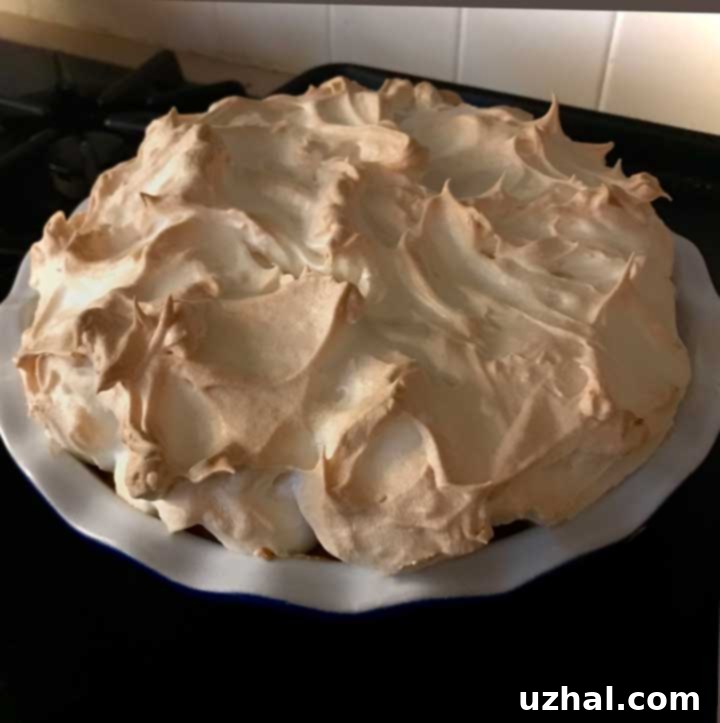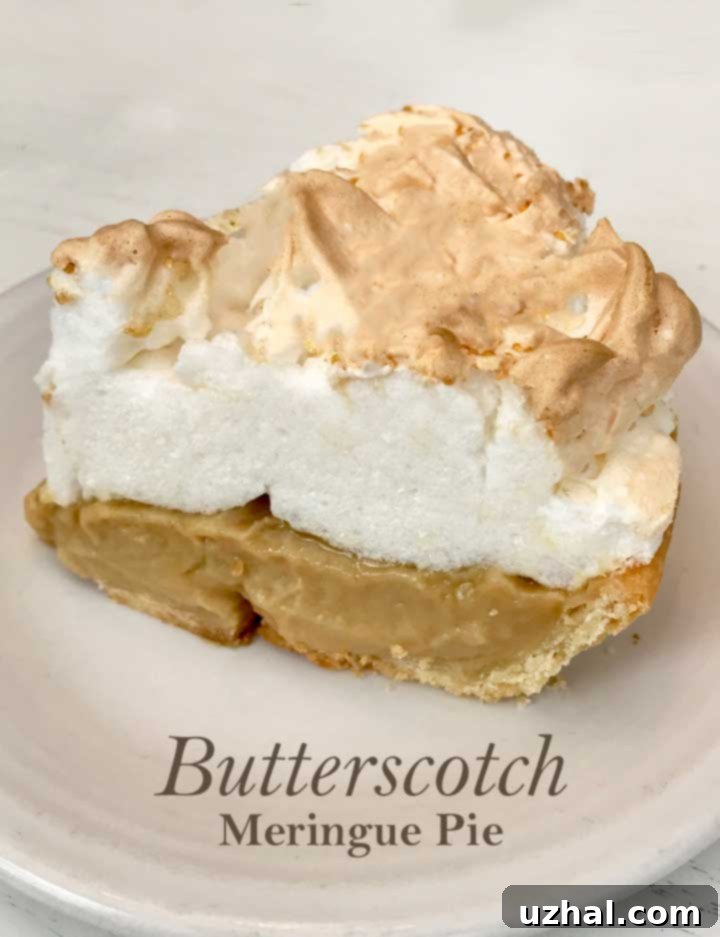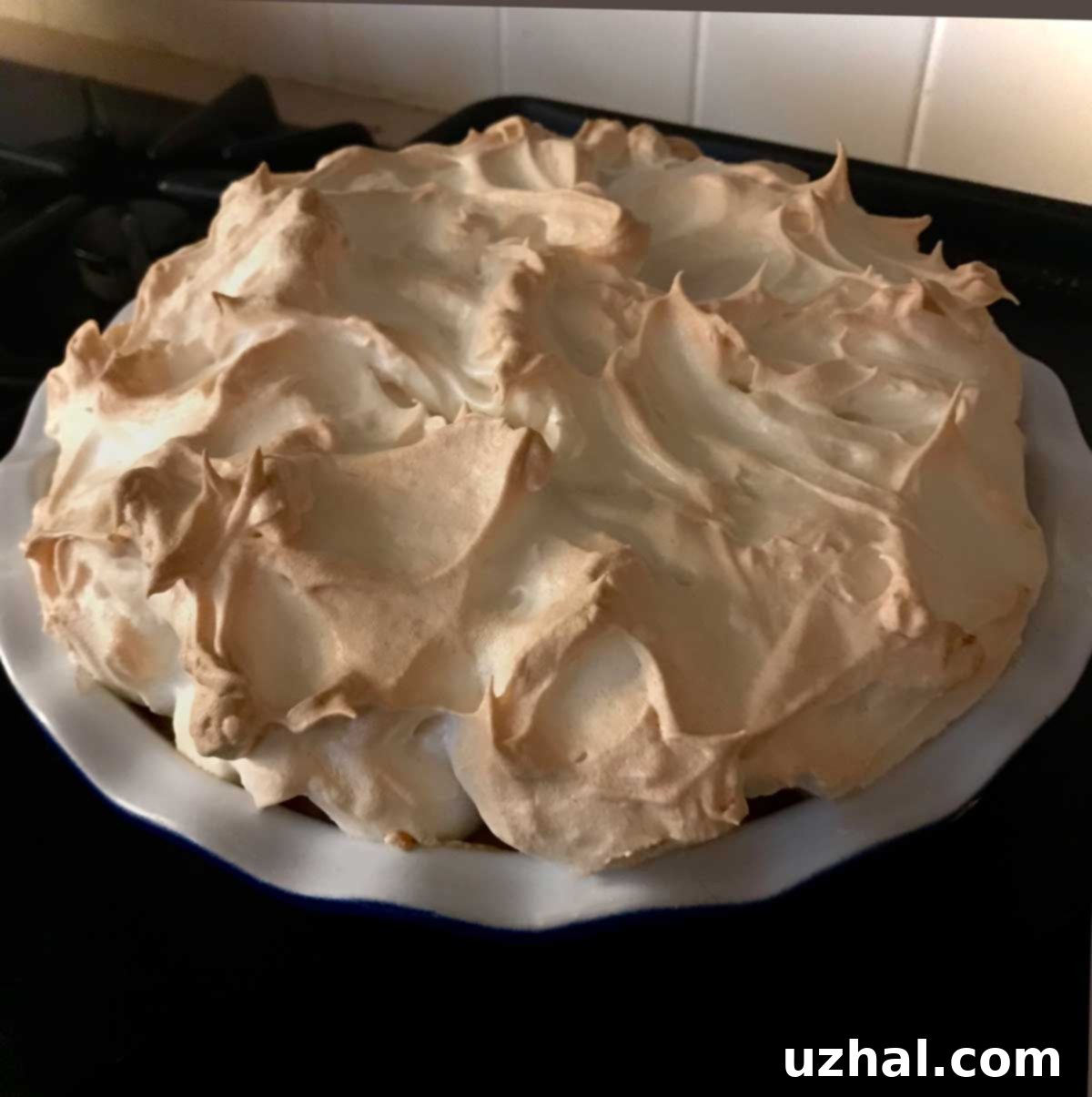The Ultimate Guide to Crafting the Perfect Butterscotch Meringue Pie
There are few desserts that evoke a sense of nostalgic comfort quite like a classic butterscotch meringue pie. This recipe, a treasured favorite originally inspired by Classic Home Desserts, has been perfected over time through countless baking sessions. It delivers an unparalleled blend of rich, creamy butterscotch filling crowned with a towering, fluffy meringue. Over the years, I’ve discovered several crucial tips that elevate this pie from merely good to absolutely sublime. Firstly, embracing the richness of whole milk is non-negotiable for achieving that luscious, smooth texture in the filling. Secondly, preventing a runny filling is paramount; ensure you cook the mixture for a full three minutes *after* it comes to a boil. This extended cooking time is the secret to a perfectly set pie. Lastly, the freshness of your cream of tartar for the meringue cannot be overstated. An old or compromised cream of tartar can significantly impact the stability and volume of your meringue, so always start with a fresh, odor-free batch.

Feast your eyes on this beautiful, recently baked butterscotch meringue pie. The golden-brown peaks of the meringue, crisp and delicate, stand proudly above a glistening, deeply flavorful butterscotch filling. What I particularly adore about this specific recipe is its simplicity and accessibility. The ingredients required are so wonderfully basic – items you likely already have stocked in your pantry and refrigerator. This means the craving for a homemade butterscotch pie can be satisfied with minimal fuss and no special shopping trips. While the recipe traditionally calls for three large egg whites for the meringue, I often find myself reaching for a fourth. If you, like me, appreciate a grander, more substantial, and intensely fluffy meringue, feel free to use four egg whites and adjust the sugar accordingly by increasing it. I’ve made sure to include this helpful tip in the notes section of the recipe for easy reference. This slight adjustment can transform an already impressive pie into an absolute showstopper.

Perhaps you’re captivated by the allure of a rich butterscotch pie but find yourself intimidated by the art of meringue, or simply prefer a lighter, less dramatic topping. If so, don’t fret! The delightful world of butterscotch desserts still has plenty to offer. For those who prefer a simpler, yet equally decadent, experience, I highly recommend exploring this recipe for Butterscotch Cream Pie. It offers all the deep, caramelized flavor of butterscotch without the meringue, typically opting for a generous dollop of freshly whipped cream instead. It’s a fantastic alternative that promises satisfaction without the extra steps of whipping and baking egg whites.
Mastering the perfect butterscotch meringue pie is a truly rewarding endeavor. Each bite offers a symphony of textures and flavors: the tender, flaky crust, the silky-smooth, intensely flavored butterscotch custard, and the ethereal, airy meringue that provides a sweet, slightly toasted counterpoint. This pie is more than just a dessert; it’s an experience, a celebration of classic American baking that brings joy to any table. Whether you’re preparing it for a special occasion, a family gathering, or simply to treat yourself, this recipe will guide you to butterscotch meringue pie perfection.
One of the beauties of this recipe is its fundamental simplicity, allowing the quality of each ingredient to shine. From the specific type of milk to the nuances of brown sugar, every component plays a vital role in building the pie’s signature flavor profile. Let’s delve a little deeper into these essential elements and the techniques that ensure your butterscotch pie is a triumph every single time.
Choosing the right ingredients is the first step towards a spectacular pie. For instance, using whole milk instead of skim or low-fat milk is not merely a suggestion; it’s a critical component for achieving the filling’s desired richness and creamy mouthfeel. The higher fat content in whole milk contributes to a luxuriously smooth custard that sets beautifully. Similarly, the combination of both light and dark brown sugars adds depth and complexity to the butterscotch flavor. Light brown sugar provides a delicate caramel note, while dark brown sugar introduces a more intense, molasses-like richness, creating a balanced and robust profile.
When it comes to the butter, if you can source a high-quality salted European-style butter, you’ll notice a remarkable difference. Its higher fat content and subtle saltiness will enhance the butterscotch flavor, adding another layer of deliciousness to the pie. However, if European-style butter isn’t readily available, a good quality unsalted butter will still yield excellent results; just be sure not to omit the pinch of salt mentioned in the recipe, as it’s vital for balancing the sweetness and intensifying the overall flavor. The vanilla extract, often overlooked, is a powerful flavor enhancer. Opt for a pure vanilla extract for the best results, as it will truly elevate the butterscotch notes rather than just adding a generic sweetness.
The pie crust itself forms the foundation of this delectable dessert. A pre-baked, or “blind-baked,” 9-inch pie crust is essential to prevent a soggy bottom once the moist filling is added. Whether you prefer to use a homemade flaky pastry or a high-quality store-bought crust, ensure it’s fully baked and cooled before pouring in the hot butterscotch filling. This attention to detail with the crust ensures a perfect textural contrast to the smooth filling and light meringue.
Now, let’s talk about that glorious meringue. The egg whites must be at room temperature to achieve maximum volume when whipped. This simple trick allows the proteins in the egg whites to relax, incorporating more air and resulting in a lighter, fluffier meringue. Cream of tartar, a mild acid, is added to stabilize the egg whites, helping them hold their shape and preventing them from deflating. Just like the butterscotch filling, the specific order and method of adding ingredients to the meringue are key to its success. Slowly incorporating the sugar while beating the egg whites ensures that the sugar dissolves properly, leading to a glossy, stable, and truly spectacular meringue that will hold its distinct peaks beautifully when baked.
Recipe: Classic Butterscotch Meringue Pie

Butterscotch Meringue Pie
Recipe by Cookie Madness
Pin Recipe
Ingredients
- 3 large egg yolks at room temperature, vital for smooth blending and rich custard texture.
- 4 tablespoons all-purpose flour This acts as the primary thickener for the creamy filling.
- 2 cups whole milk warmed slightly in microwave (about 30-45 seconds) to prevent shocking the eggs and aid in smooth mixing. Whole milk provides crucial richness.
- 1 big pinch salt Essential for balancing sweetness and enhancing butterscotch flavor.
- 4 tablespoons unsalted butter For a superior flavor, use a high-quality salted European-style butter if possible; otherwise, unsalted works fine.
- ½ cup light brown sugar (100 grams) Adds a delicate caramel note to the butterscotch.
- ½ cup dark brown sugar (100 grams) Contributes a deeper, richer molasses flavor profile.
- 1 teaspoon pure vanilla extract Use good quality vanilla for the best flavor.
- 1 9-inch pie crust, baked Ensure it is fully blind-baked and cooled to prevent a soggy bottom.
For the Meringue
- 3 large egg whites** at room temperature for optimal volume when whipping.
- ½ teaspoon vanilla extract Adds a subtle aroma and flavor to the meringue.
- ¼ teaspoon cream of tartar Crucial for stabilizing the egg whites and achieving stiff peaks. Ensure it’s fresh.
- 6 tablespoons granulated sugar Gradually added to create a glossy, stable meringue.
Instructions
-
Prepare Your Oven: Preheat your oven to 350 degrees F (175 degrees C). This ensures your oven is at the correct temperature for the meringue to brown evenly once it’s on the pie.
-
Meringue Prep: Measure out all the ingredients for your meringue beforehand. You’ll need to work swiftly to get the meringue onto the hot filling, so having everything ready is key to success.
-
Combine Egg Yolks and Milk Mixture: In a medium-sized bowl, vigorously whisk the 3 egg yolks until they are uniformly combined and slightly lightened in color. In a separate, larger bowl, whisk together the flour with half of the slightly warmed whole milk until the mixture is completely smooth and free of any lumps. This prevents lumps from forming when adding the yolks. Then, gradually whisk the beaten egg yolks and the big pinch of salt into the milk and flour mixture until fully incorporated. Finally, whisk in the remaining cup of whole milk. Set this prepared liquid mixture aside.
-
Cook the Butterscotch Filling: Place the unsalted butter in a heavy-bottomed saucepan and melt it gently over medium heat. Once the butter is mostly melted, add both the light and dark brown sugars. Whisk or stir continuously for approximately 2 minutes, ensuring the butter is fully melted and the sugars have completely dissolved into a smooth, fragrant mixture. Next, slowly whisk the reserved milk mixture into the saucepan. Continue to whisk constantly over medium heat. The mixture will gradually thicken and begin to bubble vigorously. This process should take only 2-3 minutes to reach a boil. Once large bubbles consistently form, signifying a full boil, continue whisking for an additional 3 minutes. This crucial step prevents the filling from becoming runny and ensures it sets perfectly.
-
Add Vanilla and Fill Crust: Remove the saucepan from the heat immediately after the 3-minute boiling period. Stir in the pure vanilla extract. Promptly pour the hot butterscotch filling into your pre-baked pie crust. Work quickly to prepare the meringue so you can spread it over the hot filling; the residual heat from the filling helps to gently cook the underside of the meringue, creating a stable base.
-
Prepare and Top with Meringue: In a clean, dry bowl (preferably a metal or glass bowl to avoid any grease), beat the room temperature egg whites and cream of tartar with an electric mixer on medium-high speed until soft peaks just begin to form. Beat in the vanilla extract. Then, gradually and slowly add the granulated sugar, about one tablespoon at a time, while continuing to beat. Increase the mixer speed to high and continue beating until the mixture is very thick, glossy, and forms stiff, upright peaks that hold their shape. Carefully scrape the fluffy meringue over the hot butterscotch filling, ensuring it reaches and seals the edges of the pie crust to prevent shrinkage. You can create decorative swirls or peaks with the back of a spoon. Place the pie on a baking sheet (to catch any potential drips) and bake in the preheated 350°F (175°C) oven for 10-15 minutes, or until the meringue’s peaks are beautifully golden brown.
-
Cool and Chill: Allow the baked pie to cool completely at room temperature for at least an hour. This initial cooling allows the filling to begin setting and prevents condensation. After an hour, carefully transfer the pie to the refrigerator and chill for a minimum of 4 hours, or ideally until fully set and firm. This chilling time is essential for the filling to achieve its perfect sliceable consistency.
Notes for Success
There’s an undeniable magic in creating a dessert from scratch that tastes even better than you imagined. This butterscotch meringue pie is one of those recipes – a timeless classic that, with a little care and attention to these detailed instructions and tips, will impress everyone who tries a slice. Enjoy the process of baking and the sheer delight of serving this magnificent pie!
